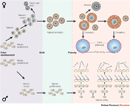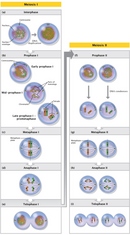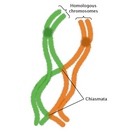Alleles Separate During Gamete Formation and Come Together Again
How is the same procedure responsible for genetic recombination and diverseness besides the cause of aneuploidy? Understanding the steps of meiosis is essential to learning how errors occur.

Organisms that reproduce sexually are thought to have an advantage over organisms that reproduce asexually, because novel combinations of genes are possible in each generation. Furthermore, with few exceptions, each individual in a population of sexually reproducing organisms has a singled-out genetic composition. We have meiosis to thank for this diverseness.
Meiosis, from the Greek word meioun, meaning "to make small," refers to the specialized process by which germ cells divide to produce gametes. Considering the chromosome number of a species remains the same from one generation to the adjacent, the chromosome number of germ cells must be reduced past half during meiosis. To accomplish this feat, meiosis, unlike mitosis, involves a single circular of DNA replication followed past two rounds of cell division (Figure 1). Meiosis also differs from mitosis in that information technology involves a process known as recombination, during which chromosomes substitution segments with one some other. Equally a result, the gametes produced during meiosis are genetically unique.
Researchers' initial understanding of meiosis was based upon careful observations of chromosome beliefs using light microscopes. Then, in the 1950s, electron microscopy provided scientists with a glimpse of the intricate structures formed when chromosomes recombine. More recently, researchers take been able to identify some of the molecular players in meiosis from biochemical analyses of meiotic chromosomes and from genetic studies of meiosis-specific mutants.
Meiosis Is a Highly Regulated Process

Meiosis represents a survival mechanism for some simple eukaryotes such as yeast. When atmospheric condition are favorable, yeast reproduce asexually by mitosis. When nutrients get limited, nonetheless, yeast enter meiosis. The commitment to meiosis enhances the probability that the side by side generation will survive, because genetic recombination during meiosis generates four reproductive spores per cell, each of which has a novel genotype. The entry of yeast into meiosis is a highly regulated procedure that involves significant changes in gene transcription (Lopez-Maury et al., 2008). By analyzing yeast mutants that are unable to complete the various events of meiosis, investigators have been able to identify some of the molecules involved in this complex process. These controls have been strongly conserved during evolution, and so such yeast experiments have provided valuable insight into meiosis in multicellular organisms equally well.
In most multicellular organisms, meiosis is restricted to germ cells that are set aside in early development. The germ cells reside in specialized environments provided past the gonads, or sexual activity organs. Within the gonads, the germ cells proliferate by mitosis until they receive the right signals to enter meiosis.
In mammals, the timing of meiosis differs greatly between males and females (Figure 2). Male person germ cells, or spermatogonia, practice not enter meiosis until later puberty. Even then, only limited numbers of spermatogonia enter meiosis at any ane time, such that adult males retain a pool of actively dividing spermatogonia that acts as a stalk cell population. On the other mitt, meiosis occurs with quite different kinetics in mammalian females. Female germ cells, or oogonia, stop dividing and enter meiosis within the fetal ovary. Those germ cells that enter meiosis become oocytes, the source of future eggs. Consequently, females are born with a finite number of oocytes arrested in the first meiotic prophase. Within the ovary, these oocytes grow within follicle structures containing big numbers of back up cells. The oocytes will reenter meiosis merely when they are ovulated in response to hormones. Human being females, for example, are born with hundreds of thousands of oocytes that remain arrested in the first meiotic prophase for decades. Over time, the quality of the oocytes may deteriorate; indeed, researchers know that many oocytes die and disappear from ovaries in a process known as atresia.
Meiosis Consists of a Reduction Division and an Equational Division
Ii divisions, meiosis I and meiosis II, are required to produce gametes (Effigy 3). Meiosis I is a unique prison cell partitioning that occurs only in germ cells; meiosis II is similar to a mitotic division. Before germ cells enter meiosis, they are generally diploid, meaning that they have two homologous copies of each chromosome. So, simply before a germ cell enters meiosis, information technology duplicates its Dna so that the cell contains four DNA copies distributed between two pairs of homologous chromosomes.
Meiosis I

Compared to mitosis, which can have place in a matter of minutes, meiosis is a slow process, largely considering of the time that the prison cell spends in prophase I. During prophase I, the pairs of homologous chromosomes come up together to form a tetrad or bivalent, which contains four chromatids. Recombination can occur between any two chromatids inside this tetrad structure. (The recombination process is discussed in greater detail afterwards in this commodity.) Crossovers between homologous chromatids tin be visualized in structures known as chiasmata, which announced late in prophase I (Figure four). Chiasmata are essential for accurate meioses. In fact, cells that fail to form chiasmata may not be able to segregate their chromosomes properly during anaphase, thereby producing aneuploid gametes with aberrant numbers of chromosomes (Hassold & Hunt, 2001).
At the end of prometaphase I, meiotic cells enter metaphase I. Here, in sharp contrast to mitosis, pairs of homologous chromosomes line upwardly opposite each other on the metaphase plate, with the kinetochores on sister chromatids facing the same pole. Pairs of sexual practice chromosomes too align on the metaphase plate. In homo males, the Y chromosome pairs and crosses over with the X chromosome. These crossovers are possible considering the Ten and Y chromosomes accept pocket-size regions of similarity virtually their tips. Crossover between these homologous regions ensures that the sex activity chromosomes volition segregate properly when the cell divides.
Next, during anaphase I, the pairs of homologous chromosomes split to different daughter cells. Before the pairs can separate, yet, the crossovers betwixt chromosomes must exist resolved and meiosis-specific cohesins must be released from the arms of the sister chromatids. Failure to separate the pairs of chromosomes to different daughter cells is referred to as nondisjunction, and information technology is a major source of aneuploidy. Overall, aneuploidy appears to be a relatively frequent event in humans. In fact, the frequency of aneuploidy in humans has been estimated to be equally loftier as 10% to 30%, and this frequency increases sharply with maternal age (Hassold & Hunt, 2001).
Meiosis II

Following meiosis I, the daughter cells enter meiosis Two without passing through interphase or replicating their Dna. Meiosis II resembles a mitotic division, except that the chromosome number has been reduced by half. Thus, the products of meiosis Two are four haploid cells that comprise a unmarried re-create of each chromosome.
In mammals, the number of feasible gametes obtained from meiosis differs between males and females. In males, four haploid spermatids of similar size are produced from each spermatogonium. In females, however, the cytoplasmic divisions that occur during meiosis are very asymmetric. Fully grown oocytes within the ovary are already much larger than sperm, and the time to come egg retains virtually of this volume equally it passes through meiosis. Every bit a effect, merely ane functional oocyte is obtained from each female meiosis (Figure 2). The other three haploid cells are pinched off from the oocyte as polar bodies that contain very little cytoplasm.
Recombination Occurs During the Prolonged Prophase of Meiosis I

Prophase I is the longest and arguably most important segment of meiosis, because recombination occurs during this interval. For many years, cytologists have divided prophase I into multiple segments, based upon the appearance of the meiotic chromosomes. Thus, these scientists take described a leptotene (from the Greek for "thin threads") phase, which is followed sequentially past the zygotene (from the Greek for "paired threads"), pachytene (from the Greek for "thick threads"), and diplotene (from the Greek for "2 threads") phases. In recent years, cytology and genetics accept come together so that researchers at present sympathise some of the molecular events responsible for the stunning rearrangements of chromatin observed during these phases.
Recall that prophase I begins with the alignment of homologous chromosome pairs. Historically, alignment has been a difficult problem to arroyo experimentally, but new techniques for visualizing individual chromosomes with fluorescent probes are providing insights into the process. Recent experiments propose that chromosomes from some species have specific sequences that human action equally pairing centers for alignment. In some cases, alignment appears to brainstorm as early every bit interphase, when homologous chromosomes occupy the same territory within the interphase nucleus (Figure five). Nevertheless, in other species, including yeast and humans, chromosomes practise not pair with each other until double-stranded breaks (DSBs) appear in the Deoxyribonucleic acid (Gerton & Hawley, 2005). The formation of DSBs is catalyzed by highly conserved proteins with topoisomerase activity that resemble the Spo11 protein from yeast. Genetic studies accept shown that Spo11 activity is essential for meiosis in yeast, because spo11 mutants fail to sporulate.
Following the DSBs, 1 Dna strand is trimmed dorsum, leaving a iii′-overhang that "invades" a homologous sequence on another chromatid. Every bit the invading strand is extended, a remarkable construction called synaptonemal complex (SC) develops around the paired homologues and holds them in close register, or synapsis. The stability of the SC increases every bit the invading strand beginning extends into the homologue and then is recaptured by the broken chromatid, forming double Holliday junctions. Investigators have been able to observe the process of SC formation with electron microscopy in meiocytes from the Allium plant (Figure 6). Bridges approximately 400 nanometers long begin to course betwixt the paired homologues post-obit the DSB. Only a fraction of these bridges volition mature into SC; moreover, not all Holliday junctions volition mature into crossover sites. Recombination volition thus occur at just a few sites forth each chromosome, and the products of the crossover will become visible as chiasmata in diplotene later on the SC has disappeared (Zickler & Kleckner, 1999).

Figure half-dozen: Visualization of chromosomal bridges in Allium fistulosum and Allium cepa (plant) meiocytes.
The sites of double-stranded pause (DSB) dependent homologue interaction can exist seen as approximately 400 nm bridges betwixt chromosome axes. These bridges, which probably contain a DSB that is already engaged in a nascent interaction with its partner Dna, occur in big numbers. Their formation depends on the RecA (recombination protein) homologues that are expressed in this species. In the adjacent phase of homologue interaction, these nascent interactions are converted to stable strand-invasion events. This nucleates the formation of the synaptonemal complex (SC).
© 2005 Nature Publishing Group Gerton, J. Fifty. & Hawley, R. Due south. Homologous chromosome interactions in meiosis: diversity amidst conservation. Nature Reviews Genetics 6, 481 (2005). All rights reserved. ![]()
References and Recommended Reading
Gerton, J. 50., & Hawley, R. S. Homologous chromosome interactions in meiosis: Variety amidst conservation. Nature Reviews Genetics 6, 477–487 (2005) doi:10.1038/nrg1614 (link to article)
Hassold, T., & Hunt, P. To err (meiotically) is man: The genesis of human aneuploidy. Nature Reviews Genetics two, 280–291 (2001) doi:10.1038/35066065 (link to article)
Lopez-Maury, L., Marguerat, S., & Bahler, J. Tuning cistron expression to changing environments: From rapid responses to evolutionary adaptation. Nature Reviews Genetics ix, 583–593 (2008) doi:x.1038/nrg2398 (link to article)
Marston, A. 50., & Amon, A. Meiosis: Cell-wheel controls shuffle and deal. Nature Reviews Molecular Cell Biological science five, 993–1008 (2004) doi:10.1038/nrm1526 (link to article)
Page, Southward. L., & Hawley, R. S. Chromosome choreography: The meiotic ballet. Scientific discipline 301, 785–789 (2003)
Petes, T. D. Meiotic recombination hot spots and cold spots. Nature Reviews Genetics 2, 360–369 (2001) doi:ten.1038/35072078 (link to article)
Zickler, D., & Kleckner, N. Meiotic chromosomes: Integrating structure and part. Annual Review of Genetics 33, 603–754 (1999)
Source: http://www.nature.com/scitable/topicpage/meiosis-genetic-recombination-and-sexual-reproduction-210
0 Response to "Alleles Separate During Gamete Formation and Come Together Again"
Post a Comment